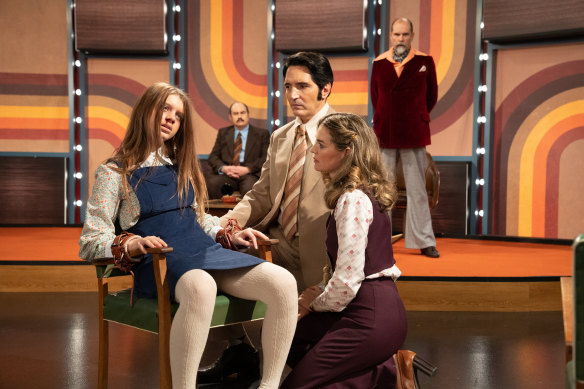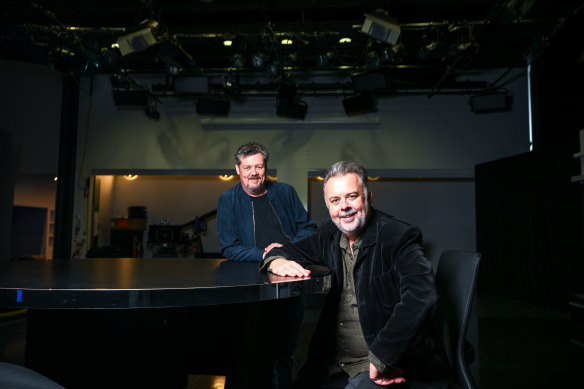This was published 1 year ago
Don Lane, the Devil, and why Aussie horror is taking over the world
Hot on the heels of Talk To Me, the Cairnes brothers’ Late Night With the Devil is the latest Aussie horror flick to attract worldwide buzz, and box office.
By Karl Quinn

Ingrid Torelli as the possessed Lilly, David Dastmalchian as Night Owls host Jack Delroy and Laura Gordon as the psychologist June in Late Night with the Devil.
Australian horror movies are having a moment, with Talk To Me the breakout success of last year and now Late Night With the Devil, a paranormal thriller inspired by the obsessions of talk show host Don Lane, helping turn brothers Colin and Cameron Cairnes into overnight sensations – after a mere 20 years of making movies together.
“It’s taken us a while to get there,” concedes Cameron Cairnes, who has co-written and co-directed two other horror features, 100 Bloody Acres and Scare Campaign, with his older brother Colin. “I’m still trying to process the success, and whether it is success. I don’t know.”
“It seems to be going well,” adds Colin of the critical and audience acclaim that has greeted their film in the US, where it opened, according to a press release issued last week, to a suspiciously appropriate $US666,666 on its first day (by the end of its first week, it had expanded to 1500 screens – from the 200 originally planned – and topped $US6.25 million). “It’s all been pretty surreal. We should allow ourselves to enjoy this moment, Cameron. We’re gonna go and get drunk tonight.”
To the untrained eye, Late Night is an American movie. Framed as a found-footage tale from the set of a 1970s US late-night chat show, it tells the story of ratings-chasing host Jack Delroy (David Dastmalchian), who devotes the entirety of his Halloween episode to a young girl (Ingrid Torelli as Lilly) who claims to have a demon inside her. Also on the show are the woman who cares for her (Laura Gordon as June), a clairvoyant (Fayssal Bazzi as Christou) and a sceptic (Carmichael Haig as Ian Bliss). (Super)naturally enough, it all goes horribly wrong.
Much to the surprise of American audiences, the film was, in fact, shot in Melbourne’s Docklands Studios, with Dastmalchian the only import in the cast. And it draws on a thoroughly Australian source, albeit one with a thick Bronx accent.
A fixture on our screens in the 1970s and ’80s, Lane – whose eponymous weeknight variety show was co-hosted by Bert Newton – was more than curious about people who claimed they could commune with The Other Side.
”Don was this American showman who somehow landed a gig here,” explains Colin, for the benefit of anyone too young to have seen the man known as The Lanky Yank in his full glory. “He didn’t quite have the same polish and wit as [US talkshow hosts] Johnny Carson or Dick Cavett, he wore his emotions on his sleeve, which made for really interesting and sometimes tense viewing, and he clearly had an interest in the beyond, and was happy to share it and try to indoctrinate gullible Aussies into following the line.“
Lane regularly invited the likes of Uri Geller (an Israeli who claimed to be able to bend spoons with the power of his mind), Doris Stokes (an Englishwoman who “heard” the voices of the deceased), and the Warrens (the American ghost hunters famously fictionalised in the Conjuring movies) onto his show. For “balance”, he also invited the Canadian magician and sceptic James Randi on, only to storm off in a fury and tell his guest to “piss off” because he dared to question the legitimacy of Stokes’s supposed gift.
Late Night With the Devil bears big traces of all of this. But there’s a strange irony in the fact the brothers have found a degree of commercial success with a film that presents as American, given their previous work has been so resolutely Australian.
It also comes at a time when the global market has finally begun to acknowledge that the US does not have a stranglehold on the genre.
“I think there’s a strong appeal for something that is quite different to the usual American horror film,” says Ari Harrison, general manager of distributor Umbrella Entertainment. “Having something a bit more exotic – being Australian, coming from different cultures and different perspectives and different landscape settings – I think makes us very interesting.”
For a long time, says Harrison, Australian genre films made the mistake of trying to pander to foreign markets, in part because Australian audiences were resistant to homegrown entries in the field, and because screen agencies were reluctant to back horror (meaning finance had to be secured overseas).
That might mean telling stories that appeared to be set in America, but perversely it could also mean amping up a film’s Australian-ness to almost-cartoonish levels.
But in recent years, he says, “there’s been this shift to actually setting these horror films in Australia, with Australian accents, with Australian ideas and themes and little nods that Australian audiences can relate to, and little idioms – like the kangaroo in Talk To Me.
“There’s a shift now to actually focus on the Australian audience, not trying to be something that we aren’t, but also to bring in themes and ideas that are universal. It’s an authentic voice that Australian filmmakers are trying to convey, rather than a stereotypical idea of what a horror film for the American audience should look like.”

Filmmaking brothers Cameron (rear) and Colin Cairnes in the Channel Nine studio.Credit: Eddie Jim
There’s little doubt the success of Talk To Me last year played a critical role in this. Made on a budget of $US4.5 million in Adelaide by twins Danny and Michael Philippou, the debut feature from the YouTubers know as RackaRacka has taken a reported box office of $US92 million globally, making it one of the most profitable films in recent times.
After a period when they seemed to be consigned to near-irrelevance, movies are made for the cinema are making a comeback – new Screen Australia boss Deirdre Brennan recently said, “this is the moment for the resurgence of film” – and horror is leading the way.
“The great thing about horror films is that they are great for an audience to go to as a group and get scared together in the cinema,” says Harrison.
For Grant Hardie, whose Monster Pictures has been distributing horror for 15 years, there’s nothing new about the fact that the genre makes sense financially.
“Australian-produced horror comes and goes, but if gotten right it always works,” he says. “I see people consistently saying horror is having a moment, but for me, it’s not a cycle, it’s a consistent thing. You’re able to shoot in a contained environment, with less cost, without access to name cast. You can circumvent all those things in low-budget horror because, ultimately, it is concept-driven.”
UK producer Phil Hunt, whose Head Gear Films makes around 40 pictures a year, thinks Australian horror can take on the world. He has plans to develop a slate of films here, some micro-budget (around $600,000), some a little more expensive, but all at a price point that makes a return on investment highly likely.
Ultimately, though, it’s not the budgets but the filmmaking voices behind them that will determine whether they work or not.
“Australian horror does have a bit more of a thing about it,” he says, citing the likes of The Babadook and, from across the Tasman, the early movies (Braindead and Bad Taste) of Lord of the Rings director Peter Jackson as standouts. “I think there is a specific kind of Australia-NZ horror, but the beauty of it is that it can translate to anywhere really.”
In truth, horror has always been a key genre in Australian filmmaking, from Peter Weir’s The Cars That Ate Paris (1974) and Picnic at Hanging Rock (1975) to Jennifer Kent’s acclaimed The Babadook (2014), with myriad stops in between (most notably the 1980s Ozploitation films that Quentin Tarantino loves so much). And if the genre is indeed having a moment right now, its advocated believe it is one that could be sustained, with the right moves.
“The way the film industry works is if something succeeds, everyone wants it,” observes Hardie. “It’s ‘Oh, shit, that product made money; give me one of them’. So it does open doors, it does open an opportunity.”
With screen agencies and financiers more open to the genre, and more receptive audiences both at home and abroad, the key is making sure there’s a pathway for strong, original stories and storytellers to emerge.
“The smart horror filmmakers in Australia know we’re never going to be able to ape the American version of the genre,” says Colin Cairnes. “So we’re prepared to go there, we’ll try something, we’re prepared to go to darker, stranger places and not be worried about the Hollywood executives.”
“You don’t have to rely on stars,” adds his brother Cameron. “It’s more about the ideas.”
Some Aussie horror that’s worth screaming about
Talk To Me (2023) Possibly the best Aussie horror film yet, it’s unpretentious and beautifully unselfconscious, delivering at all levels, and never holds back.
Hounds of Love (2016) A gripping, visually elevated thriller, that keeps you hooked with its powerful performances. A disturbing glimpse into the dark depths of human nature.
Body Melt (1993) An outrageous horror-comedy that leaves you both cringing and laughing. Over the top, and inventive gore, and absurd humour, make it a cult classic.
The Babadook (2014) A chilling psychological horror, that masterfully builds a sense of escalating dread.
The Loved Ones (2009) A disturbing and twisted thriller that keeps you glued to the screen. A unique take on the themes of obsession and revenge. (As selected by Grant Hardie, Monster Pictures and Monster Fest.)
Sissy (2022) Revenge with best friends.
Relic (2020) Three generations of women are haunted by dementia.
The Tunnel (2011) Found-footage horror in the Sydney underground.
Godless: the Eastfield Exorcism (2023) Exorcism drama set in country Victoria.
You’ll Never Find Me (2023) A tense psychological cat-and-mouse thriller set in a caravan. (As selected by Ari Harrison, Umbrella Entertainment and Brollie streaming.)
Contact the author at kquinn@theage.com.au, follow him on Facebook at karlquinnjournalist and on Twitter @karlkwin, and read more of his work here.
Find out the next TV, streaming series and movies to add to your must-sees. Get The Watchlist delivered every Thursday.